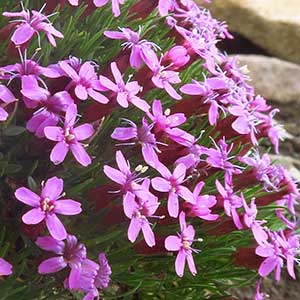Silene scaposa
Silene acaulis
Blue Mountain catchfly, Robinson's catchfly, stem campion
moss campion, silène acaule
several, erect, simple, 15–50 cm, puberulent, viscid-glandular distally.
erect, leafy proximally, 3–6(–15) cm, old leaves persistent at base.
mostly basal;
basal marcescent, long-petiolate, densely tufted, blade 1-veined, narrowly oblanceolate, 2–10(–20) cm × 2–12(–20) mm, not fleshy, base tapering to petiole, apex acute to obtuse, finely puberulent on both surfaces;
cauline in 1–3 pairs, sessile, much reduced, blade linear-lanceolate, not fleshy.
mostly basal, densely crowded and imbricate, sessile;
blade 1(–3)-veined, linear-subulate to lanceolate, 0.4–1(–1.5) cm × 0.8–1.5(–2) mm, margins cartilaginous, often ciliolate especially proximally, apex acute, glabrous to scabrous.
1–5(–7)-flowered, with terminal flower and lateral, open, pedunculate cymes often reduced to single flowers, bracteate;
bracts narrowly lanceolate, 3–10(–20) mm.
solitary flowers.
erect, elongate, 0.5–4.5 cm, glandular-puberulent.
2–40 mm.
calyx prominently 10-veined, those to lobes lance-shaped broadened and thickened distally, commissural veins slender, not forked distally, campanulate, 10–12 × 3.5–5 mm in flower, enlarging to 15 × 10 mm in fruit, not contracted around carpophore, papery, margins dentate, glandular-pubescent, viscid, veins parallel, with pale commissures, lobes patent, ovate, 1.5–4 mm, rigid, margins broad, membranous;
corolla off-white to dingy purple-red, clawed, claw exceeding calyx, ciliate proximally, broadened distally, limbs erect, 2–4-lobed, less than 1/2 length of calyx, lobes 2–5 mm, appendages 2–4, 0.5–1 mm;
stamens slightly exserted;
filaments lanate, expanded at base;
styles 3–5, ± equaling calyx.
bisexual or unisexual, all plants having both staminate and pistillate flowers, others having only pistillate flowers, subsessile or borne singly on peduncle;
calyx 10-veined, lateral veins absent, tubular to campanulate, (5–)7–10 mm, herbaceous, margins often purple tinged, dentate, sometimes ciliate, ± scarious, glabrous, lobes lanceolate to ovate, 1–2 mm;
petals bright pink, rarely white, limb unlobed to shallowly 2-fid, 2.5–3.5 mm, base tapered into claw, auricles and appendages poorly developed;
stamens exserted in staminate flowers, not so or aborted in pistillate flowers;
styles 3.
slightly longer than calyx, opening by 3–5 teeth;
carpophore 1.5–2.5 mm.
3-locular, cylindric, equaling or to 2 times calyx, opening by 6 recurved teeth;
carpophore ca. 1 mm.
brown, reniform, 1.2–2 mm, margins with large, inflated papillae, rugose on sides.
light brown, reniform, 0.8–1(–1.2) mm broad, dull, shallowly rugose.
= 48.
= 24.
Silene scaposa
Silene acaulis
Silene scaposa is a very distinct species with its subscapose inflorescence, coronalike ring of short petals, and distended fruiting calyx in which the veins to the lobes are markedly broadened and lanceolate. Variation in lobing of the corolla has been the basis for recognizing two varieties: var. scaposa (var. typica C. L. Hitchcock & Maguire), which has two-lobed petals, and var. lobata, which has four-lobed petals. However, these differences appear to be of little significance.
(Discussion copyrighted by Flora of North America; reprinted with permission.)
Silene acaulis is a variable species, and most workers have recognized infraspecific taxa in North America: subsp. acaulis (subsp. exscapa and subsp. arctica), which is predominantly arctic; and subsp. subacaulescens, which extends down the Rocky Mountains from Alaska to Arizona and New Mexico. In subsp. acaulis, the leaves are flat and short and the flowers are subsessile and smaller in size. Subspecies subacaulescens is typically a larger, less-compact plant with longer, narrower leaves and larger, pedunculate flowers. However, in many populations, these two variants are poorly differentiated, and in others both occur together, connected by intermediates.
Silene acaulis is widely distributed in arctic and alpine Europe.
(Discussion copyrighted by Flora of North America; reprinted with permission.)


